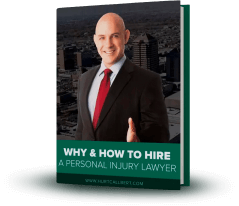
No one wants to think about being in a car accident. A car wreck can mean significant inconveniences, a loss of transportation, and serious physical injuries.
More than 400 people died in motor vehicle accidents in New Mexico in 2016, and thousands of people sustained injuries in crashes. According to the New Mexico Department of Health, traffic accident-related injuries are the leading cause of death among young people ages 1 through 24. Think it can’t happen to you? Think again. Forbes suggests that statistically, you are likely to be in about three or four car crashes during your life.
It is important to know what to do after an auto accident, including minor fender benders and those involving injuries.
Eight Steps to Take After a Car Accident
Step 1 Check for Injuries
A car accident is traumatic. Even minor impacts can stun you and leave you feeling a bit disoriented. If you’re in a car crash, take a moment to check yourself and your passengers. Here’s what to check for:
- Is anyone bleeding?
Before you do anything else, take a quick personal inventory. Are you bleeding? Are your passengers bleeding? Bleeding can be superficial, such as minor scrapes and cuts from broken glass, or bleeding can be a sign of a life-threatening injury. Apply pressure directly on the wound to slow or stop the bleeding. - Is everyone breathing and conscious?
If anyone is unconscious or not breathing, call 911 immediately. Begin performing CPR if adequately trained. Do not move an injured person unless the individual is in a vehicle on fire or is in danger of being struck by another car. - Is everyone alert and able to respond to questions?
Sometimes people will look lethargic or sluggish after an accident. They may have slurred speech or say they are tired. These can be a sign of shock from internal bleeding, head injury, or other serious conditions. - Are there any signs of visibly broken bones?
Many accident victims are stunned and don’t immediately realize that they have a bone fracture after a collision. Is anyone having pain and difficulty moving a limb? A fracture can cause internal bleeding and be life-threatening. - Is the scene safe?
The New Mexico Driver License Manual recommends moving wrecked vehicles off the road if they are drivable so that they do not block traffic or cause another accident. If the vehicles cannot be driven, use flares (if available), or other traffic hazard devices to warn oncoming drivers of the accident scene.
Step 2 Emergency Medical Care
When you call 911, be prepared to tell the emergency dispatcher how many people are injured and need ambulances. Describe the nature of their injuries to the best of your knowledge. Others can always refuse emergency care at the scene, but it’s best to have paramedics on the way, just in case.
Step 3 Summon the Police
You should call the police to report an accident, even if the damage appears to be minor. A police report will document the details of the accident and the drivers involved. If you need to file a claim against another driver, it will be more difficult to prove liability without a police report. Insurance adjusters often rely on accident reports to verify what happened at the scene of the accident. Some drivers become hostile or aggressive after an accident, and having a police officer present can help diffuse the threat of physical altercations.
Step 4 Take Photos
Some drivers wonder, “Should I take pictures after a car accident?” The answer is almost always, yes, if it’s safe.
If you have a phone with a camera, do a quick walk-around of the vehicles and the scene. Avoid standing in traffic lanes and putting yourself in danger of being struck by another vehicle. Standing in an active traffic lane is very dangerous.
Here are a few specific things to consider when photographing the scene:
- Take photos of all the damage to your vehicle and the other driver’s vehicle
- Get close-ups of the points of impact (where the vehicles made contact)
- Get wide-angle shots of the vehicles, to show the extent of damage
- Photograph skid marks and any leaks or fluid coming out of vehicles
- Photograph signs and lights and the cars in relation to landmarks
- Get a couple of shots of your injuries, if visible.
Step 5 Don’t Talk About the Accident with Other Driver
It’s human nature to want to talk to the other driver. When you’re in a car accident, you want to say certain things almost instinctively, such as, “‘I’m sorry.” But well-intentioned comments can be used as admissions to prove that you were at fault, even if you weren’t. Resist the temptation to discuss the details of the accident with the other driver. If you must talk to the other driver, try saying something like this instead: ‘Are you okay? I’ve called the police and EMS. They’re on their way. I’m going to wait in my car until they get here.’
Remember, it’s okay to check on people to see if they’re hurt. It’s okay to let them know you’ve got help on the way. Just be sure you don’t admit fault or make any remarks about how the wreck happened. That’s something you can discuss with the police when they arrive. Also, keep in mind that some people might get hostile or aggressive, avoid confrontations, and wait for the police.
Step 6 Get Comprehensive Medical Care
On the day of your accident, it’s important that you go to an emergency room to be examined. Many people worry that this is overreacting, but it’s good to be seen by a medical provider because paramedics can’t easily identify all injuries at the accident scene. You may have small fractures, torn muscles or ligaments, whiplash, or internal bleeding; not all injuries are immediately apparent. The Kessler Foundation suggests that about 1.7 million people experience a traumatic brain injury (TBI) each year, and special diagnostic tests are required to diagnose these types of injuries.
Depending on your injuries, you may be referred to a specialist like an orthopedic surgeon, so they can further assess your need for treatment. It’s essential that you make all appointments and follow your doctor’s recommendations throughout your treatment.
Step 7 Stay Away from Social Media
Social media can be a real problem for those involved in car accident cases. You may want to tell your friends about your accident through Facebook, Twitter, LinkedIn, Instagram, Snapchat, or other social media. You should not post anything about your accident on social media.
Even though you may set your profile settings to private, you have little control over posts, and information once posted. You cannot stop someone from taking a screenshot or re-sharing your posts with others. Many valid injury cases have been ruined by reckless social media posts. Your posts or pictures can be used against you by an insurance company or their attorney during negotiations or at trial.
Step 8 Talk to a Lawyer Before Accepting an Insurance Settlement
Before you talk to or agree to give a recorded statement to the insurance company or sign any documents presented by another driver’s insurance company, make sure you talk to your attorney. Insurance adjusters are paid to look for legal reasons not to pay you for your injuries. Here are some of the things an adjuster may do to diminish your case.
- Just answer some questions
Adjusters will tell you that they can’t pay your claim until they have a recorded statement from you. The questions are designed to find reasons to deny or minimize your claim. - Just sign this form
The adjuster will try to get you to sign a healthcare release that allows the insurance company to get all of your medical records. They want to look through your medical file to find old injuries or pre-existing conditions that can be used to deny your claim. They may also try to get you to sign a release, which says you can’t sue the other driver. - I can get you paid faster
Some insurance adjusters will tell you that they will pay for everything if you sign the release. However, they fail to mention that you may have future medical expenses or unresolved liens against your case. The faster the insurer can get you to settle, the faster the insurer can relieve itself of financial responsibility and leave you liable for unpaid expenses. - Do you need a lawyer?
An insurance adjuster may discourage you from seeking legal advice after an accident. Insurance companies know they have a big advantage when dealing with accident victims unfamiliar with the claims and settlement negotiations. An experienced personal injury lawyer can negotiate on your behalf for a full and fair settlement.
Experienced New Mexico Car Accident Lawyers
If you’ve been hurt in a car wreck, visit Parnall Law to get answers about your claim. The call is free and confidential, and we never get paid unless we recover compensation on your behalf. We’ve been helping injured people throughout New Mexico for over 20 years. Call us now to see if we can help you at 505-332-BERT

































